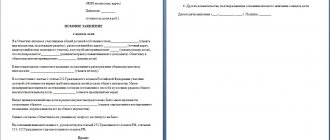Often, a residential building is owned by two or more owners at the same time. A similar situation may arise as a result of registration of shared privatization, transfer of part of the house by inheritance, or during the divorce of spouses.
The division of land into parts and subsequent registration in these cases differs significantly from standard situations. We will consider further the features of the design of a land plot with a house belonging to two owners.
Reasons for dividing a house with a plot
Circumstances in which it becomes necessary to divide property arise as a result of a variety of reasons. The basis of any of them is the presence of several owners per property.
The division of a plot of land with a residential building located on it may be required:
- During a divorce.
- As a result of inheritance by several heirs, or when inheriting part of the property when one of the owners died.
- If a house with a plot is privatized for different people.
- When real estate is acquired as shared ownership.
- When buying part of a house.
- When one of the owners creates a family.
- If hostile relations have developed between the co-owners, etc.
In practice, the division of a house into two owners is most common. This situation occurs when spouses who purchased real estate during marriage divorce.
How to divide a house into apartments, into parts
Such a division can be carried out:
- on a voluntary basis, if all parties are in favor of “sharing”. The expression of will of the parties is formalized by an appropriate agreement;
- in court, if one of the parties does not want to carry out the actual division of the house.
What is needed for the section? First of all, it is necessary to obtain a technical conclusion that would indicate that it is possible to divide the house into parts. Including what is possible: equip separate entrances, arrange separate communications.
If the case comes to the point of being considered in court, then, in the vast majority of cases, an examination is appointed.
The expert prepares a conclusion in which he indicates:
- Is it possible to divide the house;
- how can this be done, etc.
Based on a court decision, each party has the right to erect walls and create new door and window openings.
Legal and factual section
It is necessary to distinguish between the legal division of a plot with a house and the allocation of a share in kind.
Division of common property
Division of a house in the legal field implies determining the share of each owner in the property. Such a division is needed if the house and the plot were in common ownership of the owners and it is necessary to determine the size of the property of each of them.
The situation is typical for former spouses who bought or built a house during marriage. According to Art. 256 of the RF IC, property acquired during family relationships is joint and divided in half. A different size of the share can be established by agreement between the spouses . Before division, all decisions regarding the property must be made jointly.
The legal division of a house and land is usually not difficult. Each owner, by a court decision or by agreement between the owners, is assigned a share of the house and a share of the plot, which he can dispose of independently, subject to the restrictions imposed by the shared ownership regime.
Note! The owner can sell, donate, bequeath, exchange his part of the property without asking the permission of the co-owner. But the right of first refusal belongs to the second owner. All transactions for the alienation of shares are formalized through a notary. In fact, it is not necessary to allocate a share.
Allocation of share in kind
The actual division is the conversion of shared ownership into real square meters. The owner is assigned certain premises in the house, and boundaries are established for the land plot. The procedure can be carried out only after determining the share of each owner.
Unlike the legal division, allocating a share in kind is not always possible. There are prohibitions both for the distribution of land and for changing the design of the house itself .
Section restrictions
The main obstacle to allocating shares in kind in a residential building is the impossibility of constructively insulating the premises.
Division of a house is permissible if the following conditions are met:
- Each owner has a separate entrance.
- All owners must have at least one premises suitable for habitation.
- Each isolated room has a minimum set of amenities for living.
Since usually the house is not technically intended for the allocation of individual premises, before its division it is required to carry out redevelopment and reconstruction in accordance with the rules established by regional authorities. They include obtaining a building permit and compliance with fire, construction, and sanitary standards as a result of the work.
Restrictions on the division of a land plot (Article 11.9 of the Land Code of the Russian Federation):
- The size of the plot must be no less than that established by the town planning regulations of the constituent entity of the Russian Federation.
- The site must provide the possibility of using the house and other real estate located on it.
- The formation of plots should not lead to disadvantages that impede their rational use.
- The type of use of new sites must correspond to the original one.
If the house or land cannot be divided, it is possible to establish the procedure for using the real estate. The indivisibility of the plot is not an obstacle to dividing the house, and vice versa. In this case, the provisions of paragraph 1 of Art. 271 of the Civil Code: “The owner of a building, structure or other real estate located on a land plot owned by another person has the right to use the land plot provided by such person for this real estate.”
Through the court
Practice shows that the owners of the said real estate are not always able to come to a compromise and resolve the issue peacefully.
Also, stalemate situations and mistakes that preclude voluntary division of the house and land often push people to court.
In this case, the only option for dividing the land and house is a judicial procedure.
Procedure
So where to start and how to complete the forced division of real estate?
This process must go through the following steps:
- the person initiating the trial determines the size of the shares of the disputed property for each of the co-owners, establishing the possibility of carrying out a division from a technical point of view;
- a statement of claim is drawn up, the subject of which is the allocation in kind of shares of a residential building and a land plot, after which the document with all supporting documents is sent to the court;
- If the claim complies with all procedural norms, the court accepts it for proceedings, after which the process of considering the case on the merits of the stated claims begins.
- At the meeting, a technical examination may be appointed, which will determine whether a real division of the house and plot is possible.
- Based on the results of consideration of the claim, the court makes a decision to allocate shares in the disputed property to each owner or establishes the procedure for its use. In the first case, in order to finally acquire property rights to the distributed shares, the owners need to register them with the Rosreestr authorities.
Statement of claim for division of house and plot
The general requirements for a claim are reflected in Art. 131-132 Code of Civil Procedure of the Russian Federation.
A statement of claim for the division of a land plot and the premises located on it is drawn up according to the following template:
- name and location of the judicial authority;
- personal data of all parties to the process: full name, registration address and actual place of residence;
- the price of the statement of claim – the value of the property if there is a dispute;
- the descriptive part of the claim, which sets out in detail all the details of the property relations of the owners of the disputed property, the procedure for its use and the shares of each owner;
- the reasons for which it is necessary to carry out the division forcibly are indicated, and all methods used for pre-trial settlement of disputed relations are also reflected;
- the motivation part contains a list of options proposed by the plaintiff regarding the division of the house and land. The specified block must contain a legislative substantiation of the applicant’s position;
- list of additional materials;
- signature and date of document preparation.
It is better to entrust the preparation of a statement of claim to professional lawyers from the field of housing and land law. If you are determined to prepare the documents yourself, then take advantage of the free legal advice of our specialists and ask them all the questions that concern you.
Sample claim for division of house and land in kind 2021
The slightest error in the statement of claim or omission of important content requirements prescribed in Art. 131 of the Code of Civil Procedure of the Russian Federation will lead to the judge leaving the document without movement or even to returning it. And this is wasted time that could have been spent preparing for the trial.
You can use the sample below to file a claim yourself, but it is better to enlist the help of an experienced lawyer. Consultation with our specialists is completely free.
Documentation
In addition, the following documents confirming the plaintiff’s position are attached to the claim:
- copies of passports of participants in the process;
- sample claims for each side of the case under consideration;
- documents confirming property rights to the disputed property;
- cadastral passport of the land plot, technical passport of the BTI of the residential premises and other technical documentation;
- if available, expert opinions on the possibility of dividing real estate;
- confirmation of payment of state duty.
State duty
Tax and civil procedure legislation provides for the need to pay a state fee in the event of a statement of claim being submitted to the court. Taking into account the fact that this category of claims is of a property nature, the amount of tax is calculated based on the price of the statement of claim.
The rules for determining the duty are regulated by Art. 333.19 of the Tax Code of the Russian Federation according to a formula consisting of such variables as the cost of the claim, a fixed rate and the corresponding percentage.
You can calculate the fee yourself using the data from the table below.
| Cost of claim | Calculation formula |
| Up to 20 thousand rubles inclusive | 4% of the claim amount, but not less than 400 rubles. |
| From 20,001 to 100 thousand rubles | 800 rub. + 3% of the claim amount exceeding 20 thousand rubles |
| From 100,001 rub. up to 200 thousand rubles | 3200 rub. + 2% of the claim amount exceeding 100 thousand rubles |
| From 200,001 to 1 million rubles | 5200 rub. + 1% of the claim amount over 200 thousand rubles |
| More than 1 million rubles | 13200 rub. + 0.5% of the amount over 1 million rubles, but not more than 60 thousand in total |
Where to submit
If the estimated value of all property subject to division does not exceed the amount of fifty thousand rubles, then the claim is considered in the magistrate's court. If the total cost is more than the specified amount, the claim is filed with the district court at the location of the land plot. This procedure is provided for in Art. 23 Code of Civil Procedure of the Russian Federation.
It is logical that there are no houses and land plots worth less than 50 thousand rubles left even in remote provinces, therefore in 99% of cases all claims for division must be filed with the district courts at the location of the real estate to be divided.
Procedure and process of judicial division
The court session begins with hearing the parties to the case. Find out their arguments and objections.
As part of the judicial process, forensic construction and land management examinations are mandatory if the possibility of a real division is not obvious, and the house itself does not have separate exits, communications, or associated territories.
The top priority is to establish the possibility of an ideal allocation of part of the real estate; if such actions cannot be carried out, then the division takes place based on the established procedure for use.
Experts offer various options related to establishing the boundaries of newly created land plots or rooms of a residential building, which become the property of each of the parties to the dispute.
If the examination has shown the need for reconstruction or redevelopment of the premises, the court determines in its decision the nature and type of work on the reconstruction of the disputed property that the owners will need to carry out.
The allocation of a share in a residential premises represents the transfer into the possession of one of the parties to the process of an isolated area of the house, which has a separate entrance. Also, the division of residential real estate can occur if it is possible to isolate such housing through redevelopment.
In addition, the degree of legality of the decision made is determined by compliance in such a document with the requirements of various norms.
Among which:
- construction;
- fire protection;
- sanitary and hygienic, etc.
Thus, experts should take into account the possibility of arranging a separate bathroom and kitchen, and supplying utilities. Only in this case can an expert opinion serve as a sufficient attribute for making a well-founded court decision.
In the process of conducting a land management examination of the disputed plot, the original land plot is surveyed. Also, the compliance of the minimum and maximum size of newly formed real estate objects, the unchanged intended use and other rules established by current legislation is checked. The division of a land plot without carrying out such actions regarding the buildings located on it is not allowed.
If the possibility of division is confirmed, the court makes a decision with reference to the options proposed by experts.
Division of a plot with a house by agreement
Mutual agreement on the division of property is the easiest way to solve the problem.
Property owners can enter into an agreement both when determining shares in the property and when allocating square meters in kind. If the plot with the house is indivisible, the owners can independently determine the order of use of the objects. Spouses before and during marriage can enter into a marriage contract, which takes into account all the nuances of using the property acquired during the formation of the family. In addition to the size of shares and technical characteristics, it is possible to resolve issues regarding payment for housing and communal services, connection to public networks, and repairs. An agreement on the division of property is drawn up during marriage and after divorce. The marriage contract and separation agreement are certified by a notary.
Registration of shares
To register a share in a plot with a house, it is enough to present a contract or agreement to Rosreestr along with other documents:
- Application for state cadastral registration and state registration of rights.
- Passport.
- Receipt for payment of state duty.
Document packages are prepared separately for the house and plot. According to an extract from Rosreestr, the owner will own ½ or another share in the property - the same for both co-owners. Ownership mode: shared ownership.
Allocation of shares by agreement
If a share is allocated in kind, separate real estate objects are formed.
Before submitting documents you must:
- Isolate premises for each owner in accordance with urban planning rules.
- Carry out land surveying.
- Order technical plans for each isolated room inside the building.
Necessarily! A technical plan drawn up by a cadastral engineer who has a license to carry out this type of work is attached to the package of documents for each object.
As a result, each owner has an individual property that he can dispose of without restrictions. A personal address is assigned, and the shared ownership regime is terminated.
Allocation of land from shared ownership
Separation of a land plot from shared ownership is possible even if the other co-owners do not intend to sign an agreement on division and change the established principle of use of common property. To consider the issue in court, a package of documents is required: • certificate of shared ownership; • cadastral passport, which records the right to own a land plot within the established boundaries.
If a co-owner planning to separate a land plot from shared ownership has previously made improvements to the common property with the consent of other owners, the court must provide evidence of this. For example, if there are buildings and structures on the site that were erected by one of the co-owners with personal funds, these construction objects, as well as the land necessary for their maintenance, may remain with their actual owner. The rule on division in proportion to shares in a residential building continues to apply to common buildings and ancillary premises.
The allocation of parts of a land plot from common shared ownership involves compensation in favor of those co-owners whose share cannot be allocated in full for objective reasons or if one of the co-owners has such a small share that it cannot be allocated in kind.
Common shared ownership of a house does not prevent the owner from exercising the right to dispose of his property at his own discretion. However, to conclude contracts of sale, gift, exchange, pledge, will, it is advisable to have ownership of your land. Therefore, a share in the common ownership of a land plot must be allocated and documented to a specific owner.
Division of a plot with a house in court
If it is impossible to reach an agreement peacefully, the procedure for dividing the property is determined by the court. Any of the owners can contact the authority. The conduct of the process depends on the preparedness of the plaintiff.
Before the court hearing, the applicant can carry out the necessary work to allocate a share, namely, isolate the premises, prepare a technical plan and a project for dividing the plot and house. In this case, the court will order an examination, and if the expert confirms the admissibility of separating part of the real estate, it will approve the plan. Additionally, issues of compensation will be resolved if the share of one of the owners is less than the established one.
In the absence of training in the technical section, the issue of the possibility of allocating a share is decided by an expert. With this option, there is a high probability of refusal of the claim due to the indivisibility of the house and land.
The video story will tell you how you can divide a plot of land and a house
Sale of a share of a plot in common shared ownership
According to Article 37 of the Land Code of the Russian Federation, only land plots that have undergone state cadastral registration can be the object of purchase and sale. Based on Article 250 of the Civil Code of the Russian Federation, participants in common shared ownership have a pre-emptive right to purchase the share being sold when concluding sales and exchange agreements with an outsider. In this case, the selling party has the right to choose which of the co-owners will sell its part of the common shared property.
A plot of land can become private property on the basis of acquisitive prescription. According to Article 234 of the Civil Code of the Russian Federation, a citizen who conscientiously, openly and continuously owns real estate as his own for fifteen years acquires ownership of this property. This rule is applicable to private property and ownerless property and is not applicable to land plots in state and municipal ownership.
If you are thinking about selling a share of a plot that is in common shared ownership or want to exercise other rights related to your ownership of common shared property, consult with a lawyer. Competent protection of the owner's rights when concluding contracts will eliminate many problems when using the property later.
Kizimov Denis Yurievich Lawyer on land issues










